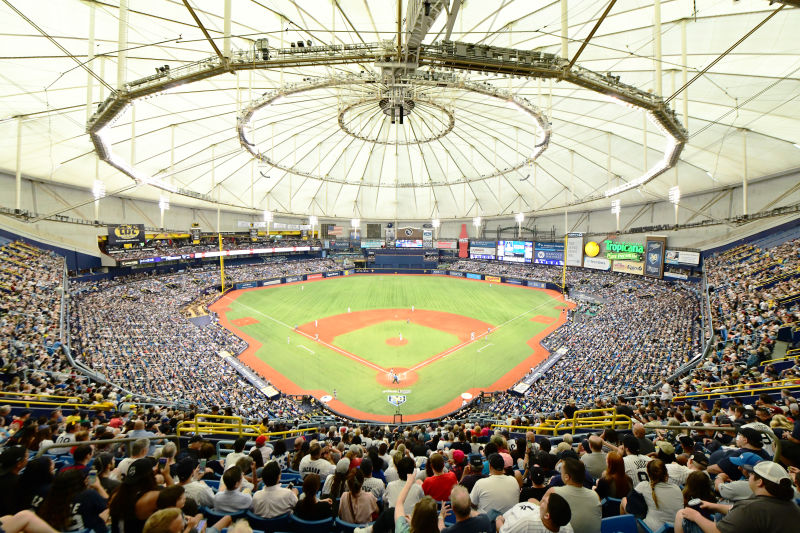- USF Takes Alabama To The Limit In 17-3 Loss
- USF, McClain Roll To First Win of the Season
- Bobby Bowden dies: Legendary coach built Florida State into college football powerhouse
- ECU hammers USF for first win of season
- Mike Brosseau’s HR off Aroldis Chapman Lifts Rays Past Yankees in ALDS Game 5
- Tom Brady Purchasing $7.5 Million Mansion
- Tampa Bay Buccaneers DT Vita Vea has broken ankle, likely out for season
- Tampa Bay Lightning have placed Tyler Johnson on Waivers
- USF football excited to bring fans back to Raymond James Stadium this weekend
- Tampa Bay Lightning Win Stanley Cup
Tampa Bay Rays Shrink Capacity For Baseball At Tropicana Field
- Updated: January 5, 2019

In their continuing quest to enhance the fan experience at Tropicana Field in St. Petersburg, the Tampa Bay Rays announced on Friday that the club will no longer sell seats in the upper deck, reducing capacity in the domed facility to a Major League Baseball low of 25,000 to 26,000.
The move comes at a time when exploration to build a new ballpark on the Tampa side of the bay has come to a complete halt.
The Rays are one of MLB’s bottom feeders, and despite 90 victories this past season in the American League East, finished second to last among MLB’s 30 teams with an overall attendance of 1,154973, and an average of 14,258 for 81 home dates.
The original capacity of the stadium when the Rays expanded into the AL in 1998 was 45,369, but the club, under two owners, has steadily decreased that capacity by tarping upper deck seats. The facility opened in 1993.
Capacity last year was 31,042, so the new configuration and seating design is a fairly minimal change. Under the prior configuration, only 10-15 of the front rows in the upper deck were available for purchase.
The Rays say the club has invested $50 million in ballpark improvements since Stu Sternberg bought the Rays from charter owner Vince Naimoli in 2005, $15 million of that now in the past two offseasons.
The latest enhancements will also include a new social gathering space in left field, redesigned stadium entrances, new synthetic playing turf, and LED lighting throughout the stadium.
“These renovations mark our continued commitment to providing a first-rate fan experience at Tropicana Field,” Rays president Matt Silverman said in a statement released by the club on Friday. “Together, in concert with the reduction in seating capacity, these investments will help create a more intimate, entertaining and appealing experience for our fans.”
The future for the team at the Trop seems to be finite with a lease that expires after the 2027 season. In a memorandum of understanding between the club and local government officials signed in 2014, there were specific buyout clauses built into the lease if the team moved to a new ballpark in the Tampa Bay area.
There were none if the team tried to move out of the area prior to the end of the lease.
The agreement, which allowed the Rays three years to look around Tampa to build a new facility, has now expired and Sternberg said prior to the holidays that he has no plans to extend it.
At the winter meetings last month at Las Vegas, Sternberg said that a proposed ballpark project on the Tampa side of the bay was dead.
The Rays unveiled plans for a 31,000-seat ballpark with a fixed glass roof this past July in Ybor City, revealing illustrations of the structure projected to cost about $900 million.
Since then, there had been no movement between the ballclub, the city of Tampa and Hillsborough County on the details of financing the plan and that because of the terms of the MOU, the parties had run out of time.
“One way or another we need to figure out where the team is going to be in 2028 if not sooner,” Sternberg said. “Ideally sooner, but absolutely by 2028.”
Though Sternberg said at the time that his organization had spent many thousands of manhours and millions of dollars trying to move the project toward fruition, he was not discouraged.
“I’m firmly committed to helping the Rays remain and thrive for decades and generations to come,” he said.
The overall problem must be solved, but Sternberg has nine years left to play in the Trop and Friday’s investment showed the club is trying to make the best of it.
The Rays have been among baseball’s worst drawing teams throughout the last decade, ranking last or next to last in the AL since 2012. They have been dead last in the AL the last four seasons averaging about 1.2 million.
The team has only drawn in excess of two million once, 2,506,294 for an average of 30,942 in its inaugural 1998 season.
All this is linked somewhat to the product on the field. Their opening day payroll of $76.4 million in 2018 was also near the bottom of the league and is targeted to decrease this coming season. They went into the offseason with just $21.8 million committed to players. Even though the Rays finished with a 90-72 record, they still finished in third place in the AL East, 18 games behind the World Series-winning Boston Red Sox,
Sternberg has a lot on his plate moving forward.
“I never like to think of never about anything,” Sternberg said. “They want to keep baseball in St. Petersburg and people have been on the record as saying that. They’ve been focused on what gives the team the best opportunity to stay. We don’t shut anything off. The political will has been good up until this point and we have good partners on both sides of the bay.”
And with Friday’s moves, the Rays are at least trying to cater to the fans they still have.



